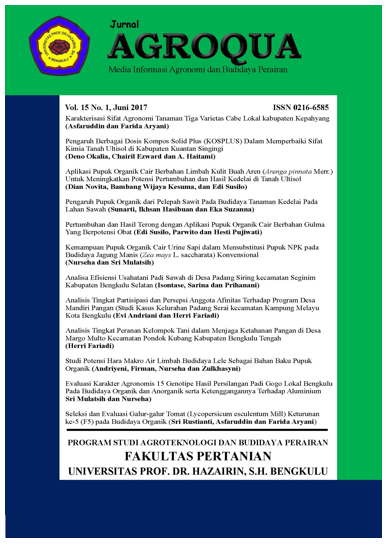EFEK PEMOTONGAN ORGAN TUBUH UDANG LOBSTER (Cherax quadricarinatus) TERHADAP PERSENTASE MOULTING DAN KELANGSUNGAN HIDUP
DOI:
https://doi.org/10.32663/ja.v20i1.2653Keywords:
cutting organs, freshwater lobster, moultingAbstract
This study aims to determine the effect of cutting the best lobster shrimp organs on the percentage of moulting and survival of freshwater crayfish (Cherax quadricarinatus). This research was carried out from April to June 2020 at the Aquaculture Laboratory of the Faculty of Agriculture, Prof. University. Dr. Hazairin, SH Bengkulu. The research was carried out for 60 days. The container used is a plastic basket measuring 29 cm long, 19 cm wide and 11 cm high as many as 20 units. The number of lobsters used for each container is 3 tails, with an initial average length of 9-12 cm/head and an initial average weight of 25-50 grams/head. The design used was a completely randomized design (CRD) with 4 treatments and 5 replications. The treatments were P1 = No Cutting (Normal), P2 = Swimming Leg Cut, P3 = Claw Cutting, and P4 = Eye Cut (Ablation). Data were analyzed by means of variance (Analysis of Variance) with a test levels of 5% and 1%. If it has a significant effect, then it is continued with the BNT test (Least Significant Difference) with a test level of 5%. The parameters observed were the percentage and survival. The results showed that cutting the organs of freshwater crayfish (Cherax quaddricarinatus) had a very significant effect on the percentage of moulting, but had no significant effect on survival. The best organ cutting is found in the claw cutting experiment with a moulting percentage of 60%. The survival of all the treatments tried was between 73%-93%.
References
Downloads
Published
Issue
Section
License
Authors who publish with this journal agree to the following terms:
- Authors grant the journal right of first publication with the work simultaneously licensed under a Creative Commons Attribution 4.0 Internasional (CC BY 4.0) Licence that allows others to use and share the work with an acknowledgment of the work's authorship and initial publication in this journal.
- The author(s) still hold the copyright of his/her/their work and retain publishing rights without restrictions such as (but not limited to) patent right, lecture, book and reproduce the article for own purposes.
















